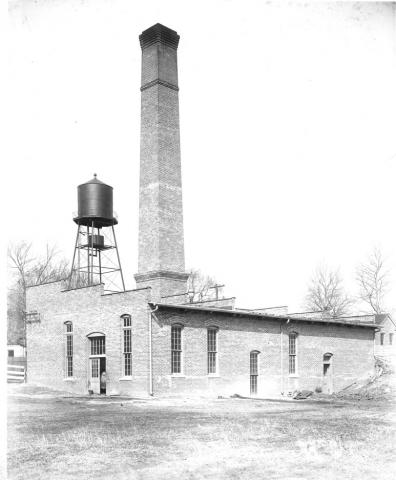
Constructed: 1911
Renovations: 1922, 1929, 1930
Map it for me
Note: Location on map is approximate.
The College Power Plant is located behind Taliaferro Hall. In 1902 plans and estimates were made for lighting and heating plants, both separate and joint. A small building with a gasoline generator was completed by 1904, and it stood behind Taliaferro and Ewell west of the Steward's House.
A committee was appointed by William & Mary to hire an architect in 1910 to draw up plans and specifications for a new lighting and heating plant. The plans were submitted in 1911 and the College accepted a bid from R.H. Richardson and Son for $5,666 to construct a brick power house and chimney with stone window sills. Smith Courtney Co. of Richmond was contracted to provide engines and electrical equipment for the plant. The power plant was completed in 1911 and was built on the College Hotel Grounds.
The Flat Hat, the College newspaper, gave the following description of the Power Plant in an article printer on October 10, 1911: "brick structure with stone trimmings, 42 feet by 70 feet, chimney 90 feet. Two boilers; two 75 horsepower engines by Harrisburg Foundry and Machine Works, Harrisburg, PA. Westinghouse generators, 50 KW; pump room, coal storage room, boiler room, engine room."
A large addition was added to the Power Plant and another boiler was installed in 1922. The new power unit was in operation by 1923, along with a 192-foot stack. The Babcock and Wilcox water tube boilers in the old power plant were no longer being used because the new $20,000-power unit was able to handle all energy needs at the time.
The power plant was enlarged once more and almost doubled in size in 1929 at a cost of $522,000. A new 250 horsepower boiler was installed along with automatic stokers. In 1930 a contract was given to Bickelhaupt, Inc., of Richmond to install a new boiler and make improvements at a cost of $24,000.
A new plant was under construction in 1952 - $350,000 was appropriated to the project with construction scheduled to start in April of that year. Major units of mechanical equipment were purchased, and the College entered a general contract with W.T. Clark and Co. for erection of the structure with an estimated cost of $399,000. The new power plant was located behind the cafeteria and burned fuel oil in contrast to the old coal-burning plant (which was used as a stand-by after completion of the new plant).
Part of the old power plant was converted into a hobby shop that opened in the fall of 1953. It had a kiln for ceramics; tools for leather, metal, and wood working; and tools and space for scenery construction for the William & Mary Theatre. The south wall of the old power plant was destroyed by Hurricane Hazel in October 1954. The boiler was also removed circa 1956 and the College took the stacks down. The College prepared the old power plant for use as a ceramics studio for the Fine Arts Department in 1976.
Photographs
1912--Colonial Echo, p. 100 (interior P1978.245)
1912--Colonial Echo (exterior P1978.244) FH, 10/03/1911, p. 1
1912--Flat Hat, 10/10/1911, p.1, p.3
1946--Colonial Echo
References
- University Archives Buildings File (2007), Power Plant, Earl Gregg Swem Library, The College of William & Mary.
